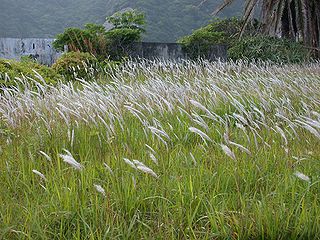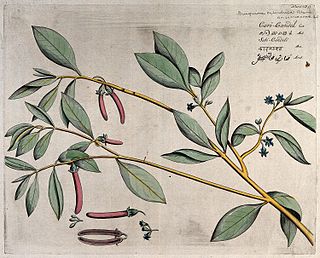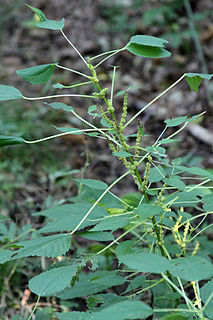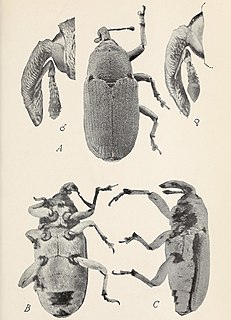
Imperata cylindrica is a species of perennial rhizomatous grass native to tropical and subtropical Asia, Micronesia, Melanesia, Australia, Africa, and southern Europe. It has also been introduced to Latin America, the Caribbean, and the southeastern United States. It is a highly flammable fire-adapted species, and can spread rapidly by colonizing disturbed areas and encouraging more frequent wildfires.

The Tephritidae are one of two fly families referred to as fruit flies, the other family being the Drosophilidae. The family Tephritidae does not include the biological model organisms of the genus Drosophila, which is often called the "common fruit fly". Nearly 5,000 described species of tephritid fruit fly are categorized in almost 500 genera of the Tephritidae. Description, recategorization, and genetic analyses are constantly changing the taxonomy of this family. To distinguish them from the Drosophilidae, the Tephritidae are sometimes called peacock flies, in reference to their elaborate and colorful markings. The name comes from the Greek τεφρος, tephros, meaning "ash grey". They are found in all the biogeographic realms.
Pyrophytes are plants which have adapted to tolerate fire.

Colobopsis saundersi, synonym Camponotus saundersi, is a species of ant found in Malaysia and Brunei, belonging to the genus Colobopsis. A worker can explode suicidally and aggressively as an ultimate act of defense, an ability it has in common with several other species in this genus and a few other insects. The ant has an enormously enlarged mandibular (jaw) gland, many times the size of a normal ant, which produces defense adhesive secretions. According to a recent study, this species forms a species complex and is probably related to C. explodens, which is part of the C. cylindrica group.

Imperata is a small but widespread genus of tropical and subtropical grasses, commonly known as satintails.

Hainardia is a genus of coastal plants in the grass family, native to the Mediterranean Basin.
Afotella is a monotypic moth genus of the family Noctuidae erected by William Barnes and Foster Hendrickson Benjamin in 1926. Its only species, Afotella cylindrica, was first described by Augustus Radcliffe Grote in 1880. It is found in western North America from Saskatchewan and Alberta south to California.
Arrhinactia is a genus of bristle flies in the family Tachinidae. There are at least two described species in Arrhinactia.

Doleschalla is a genus of bristle flies in the family Tachinidae. There are about 11 described species in Doleschalla.

Chaetostomella cylindrica is a species of tephritid or fruit flies in the genus Chaetostomella of the family Tephritidae.

Suniana lascivia, the dingy grass-dart or dingy dart, is a butterfly of the family Hesperiidae. It is found in Australia, Papua New Guinea and Indonesia.

Taractrocera papyria, the white-banded grass-dart, is a butterfly of the family Hesperiidae. It is found in the Australian Capital Territory, New South Wales, Queensland, South Australia, Tasmania, Victoria and Western Australia.

Hypocysta irius, the northern ringlet or orange-streaked ringlet, is a species of butterfly of the family Nymphalidae. It is found in Australia, including Queensland and New South Wales.

Hypocysta adiante, the orange ringlet, is a species of butterfly of the family Nymphalidae. It is found in Australia, including Queensland, New South Wales, the Northern Territory and the north of Western Australia.

Cycadeoidea is an extinct genus of bennettitalean plants known from fossil finds in North America and Europe. They lived during the Jurassic and Cretaceous periods.

Bruguiera cylindrica is a mangrove in the family Rhizophoraceae. It grows in mangrove swamps in tropical Asia.

Boehmeria cylindrica, with common names false nettle and bog hemp, is an herb in the family Urticaceae. It is widespread in eastern North America and the Great Plains from New Brunswick to Florida to Texas to Nebraska, with scattered reports of isolated populations in New Mexico, Arizona, and Utah, as well as in Bermuda, Mexico, Central America, the West Indies, and South America.
Loxoceras is a genus of orthocerids of uncertain affinity, the shell of which is a smooth orthocone with the siphuncle between the center and probably the venter. Type species: Orthocera breyni Fleming 1928. May be equivalent to Breynioceras Foerse 1939. Loxoceras has been found in Lower Carboniferous marine strata in Europe

Loxocera aristata is a species of fly and member of the family Psilidae.

Trichobaris is a genus of flower weevils in the family Curculionidae. There are 8 to 13 species in genus Trichobaris.

















